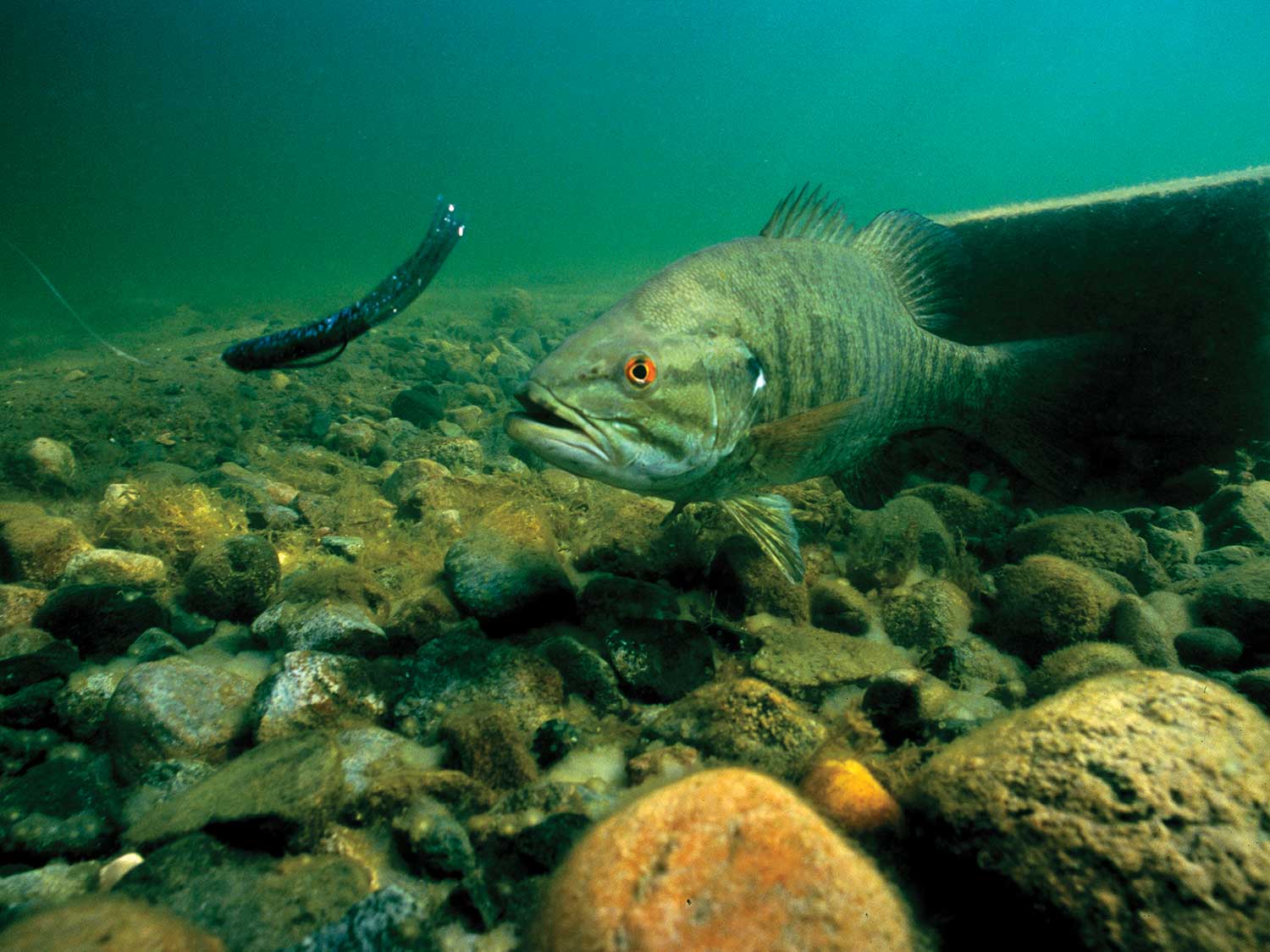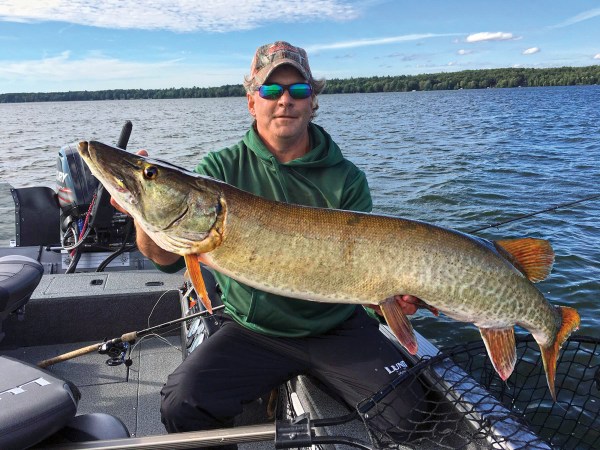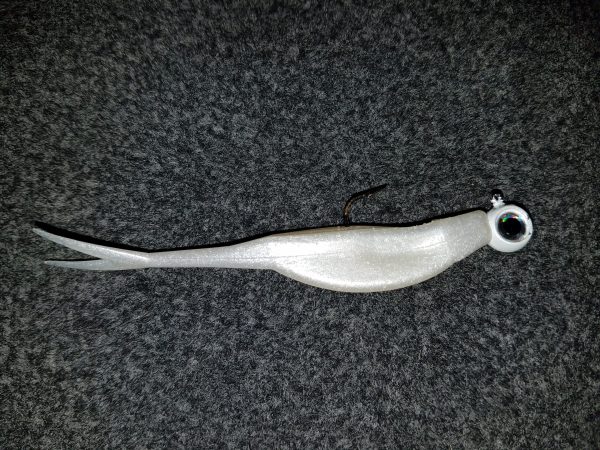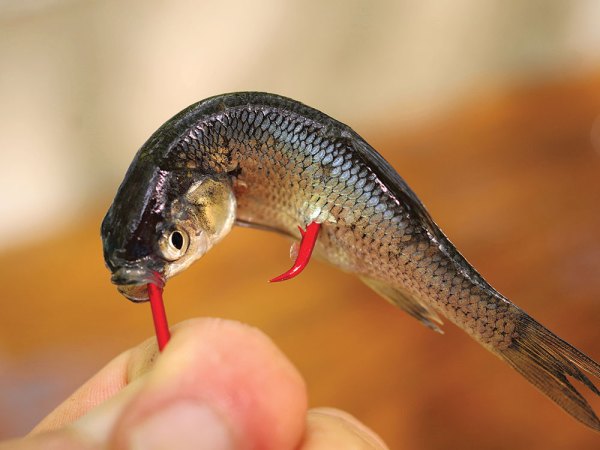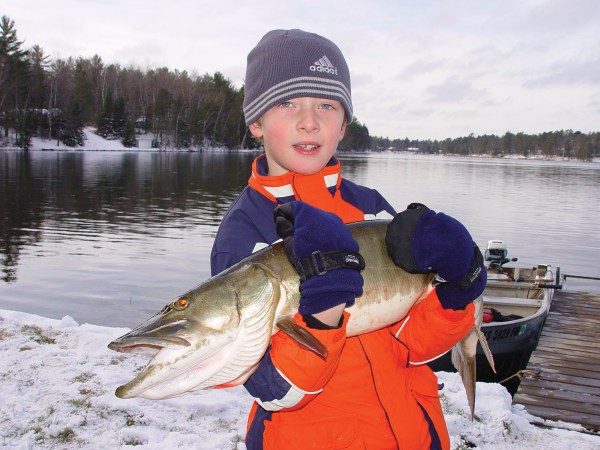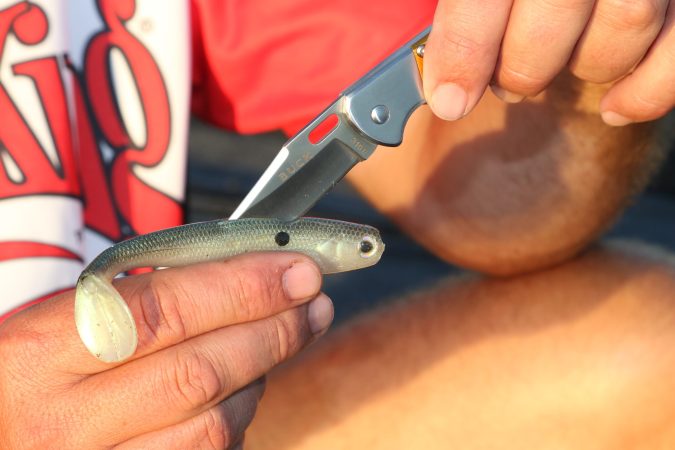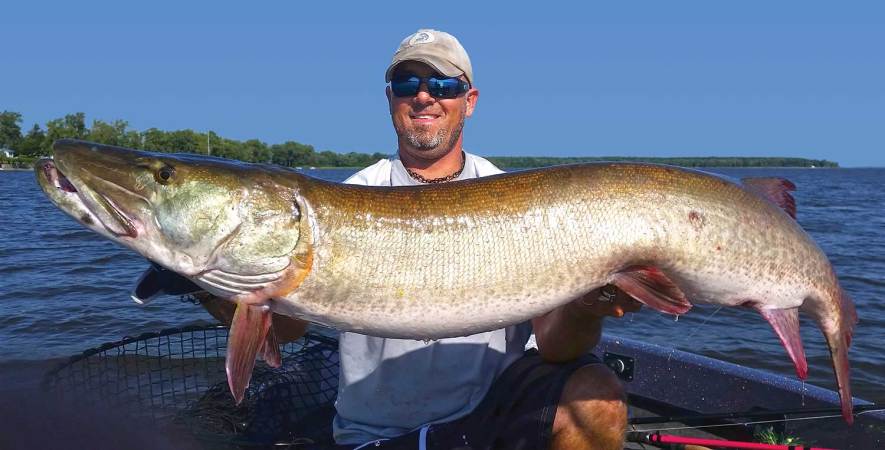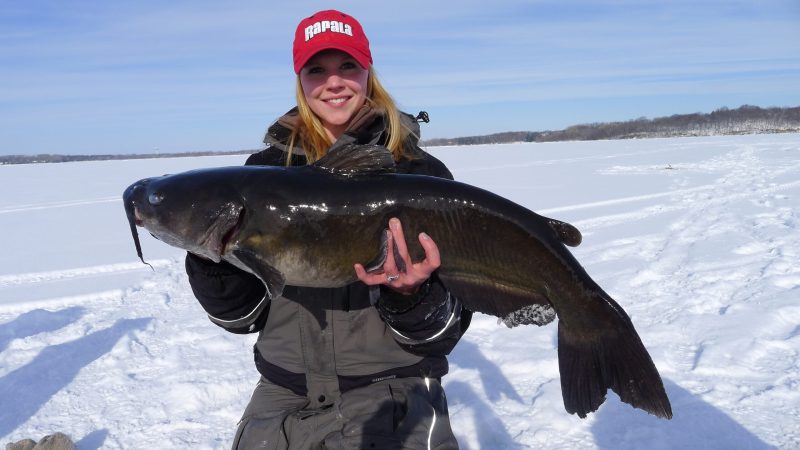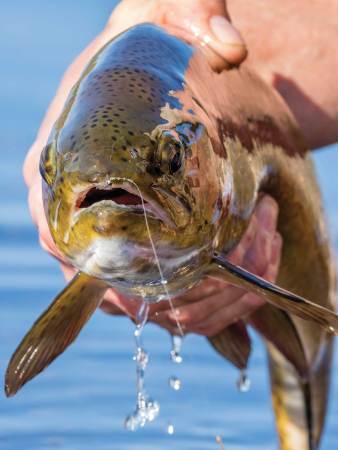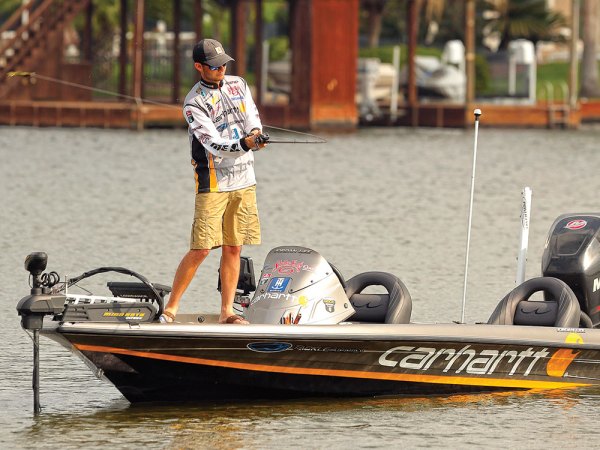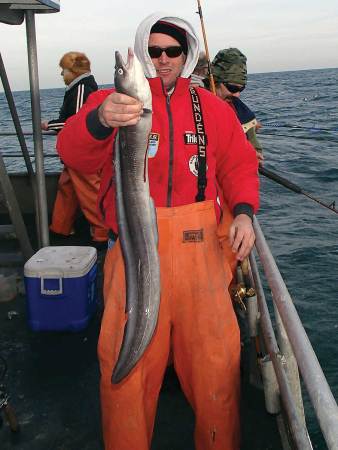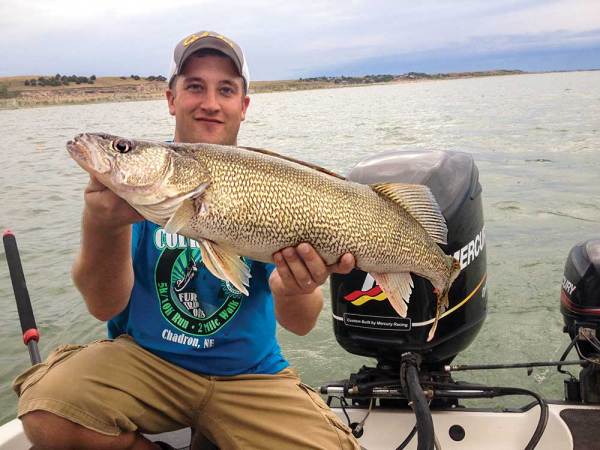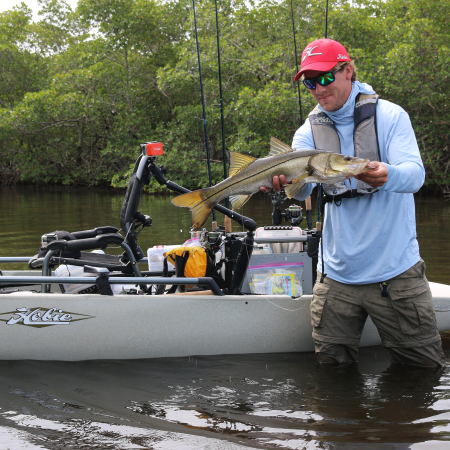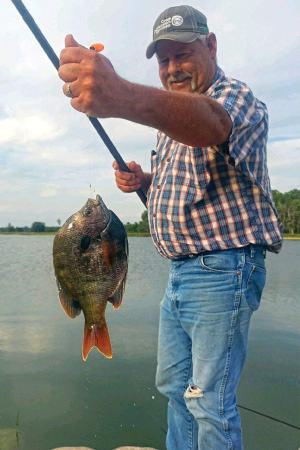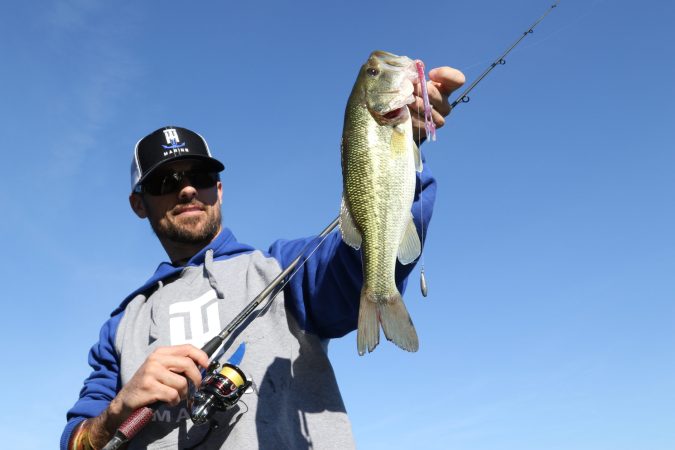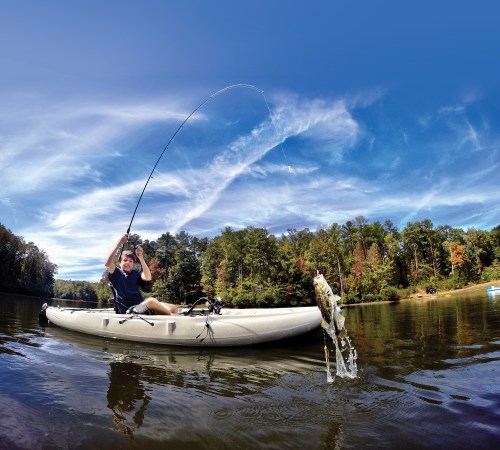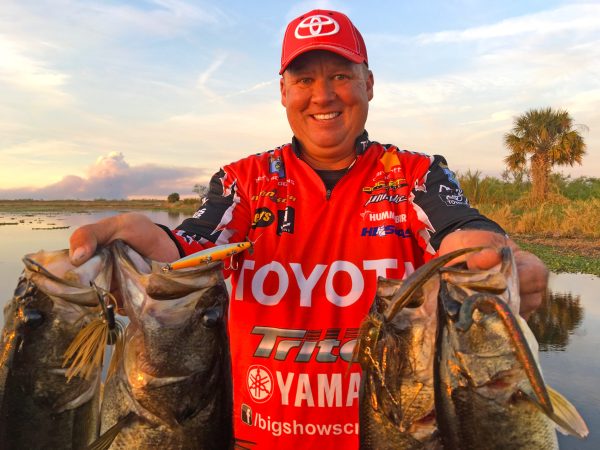Some guys hit the water looking for a quick limit, and maybe a lifetime trophy. Others are focused on the after-outing fish fry. Regardless of the reason for fishing, there is one universal theme: Catch as many as possible as fast as possible.
Here are seven tactics you’ve likely never employed, each designed to put maximum pounds in the boat.
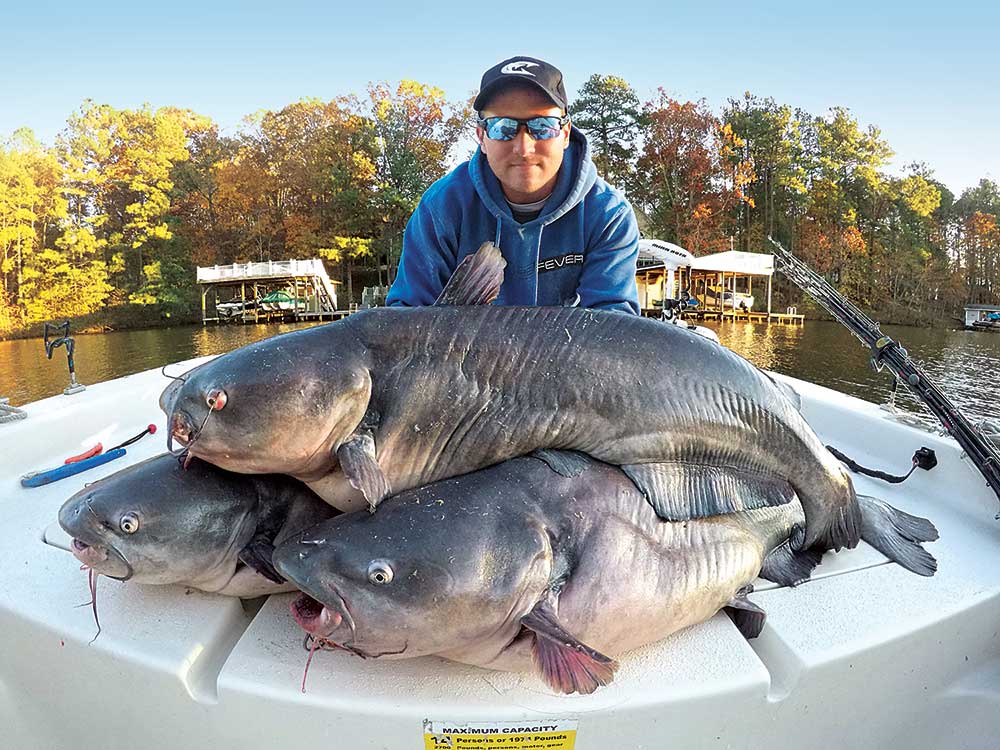
1. CATFISH
A Spread Offense for Blues
Catching a bunch of catfish can be easy. Anyone with a bucket to sit on, some stinkbait, and a patch of riverbank could fill said bucket in a few hours if luck is on his side. However, if you’re looking to fill a truck bed with a load that will seriously test the vehicle’s suspension, take notes from Zakk Royce. This 26-year-old catfish guide from Willmington, N.C., has developed an unusual system for aggressively targeting monster blue cats. If you dare to employ his methods, upgrade your shocks.
“People look at me kind of funny when I break out the planer boards to troll for catfish, but there is no more deadly presentation that I have found,” Royce says. “And when I say ‘troll’, it’s more of a stroll. Super-slow trolling at about .5 mph.”
Each rig consists of a 30-pound mono main line. To this, Royce adds a three-way swivel. On the bottom eye of the swivel, he adds a 12-inch length of 15-pound mono tied to a slinky weight. (Royce makes his own weights by crimping five to eight heavy split shots on a short length of paracord.) To the remaining eye of the swivel, Royce adds a 3-foot leader of 60-pound mono and a circle hook. About a foot in front of the hook, he adds a float to keep the bait off the bottom.
“I’ll cast my bait about 40 to 50 feet, let it hit the bottom, then attach my planer board to the main line and let out another 60 to 70 feet. I run two lines like this way behind the boat, one on each side. I’ll do another two planer-board rigs about half as far back, so they don’t tangle. And finally I’ll run two short-line rods directly behind the boat without planer boards. This covers a huge swath of water,” Royce explains.
Once his baits are set (he typically opts for cut bait, including bluegill, gizzard shad, and white perch), he trolls depth changes where blue cats are most likely to be waiting for a passing meal. Exactly how effective is this system?
“On my best day of planer-boarding, we landed 42 blue cats, and 10 of them were over 30 pounds. Last Thanksgiving, I went out by myself and had a triple. Luckily, circle hooks set themselves and the fish didn’t run over each other. I landed all three, and each fish was over 60 pounds. It was the best Thanksgiving ever.”
The secret to the system’s success, according to Royce, is that the planer boards spread out the bait. Many anglers drift right over the top of the fish with similar baits but don’t get bites. “Blue cats can be wary—especially the big ones. So, if you can present a bait to a fish that is unsuspecting, you’ll have a lot better chance of getting it to eat.”
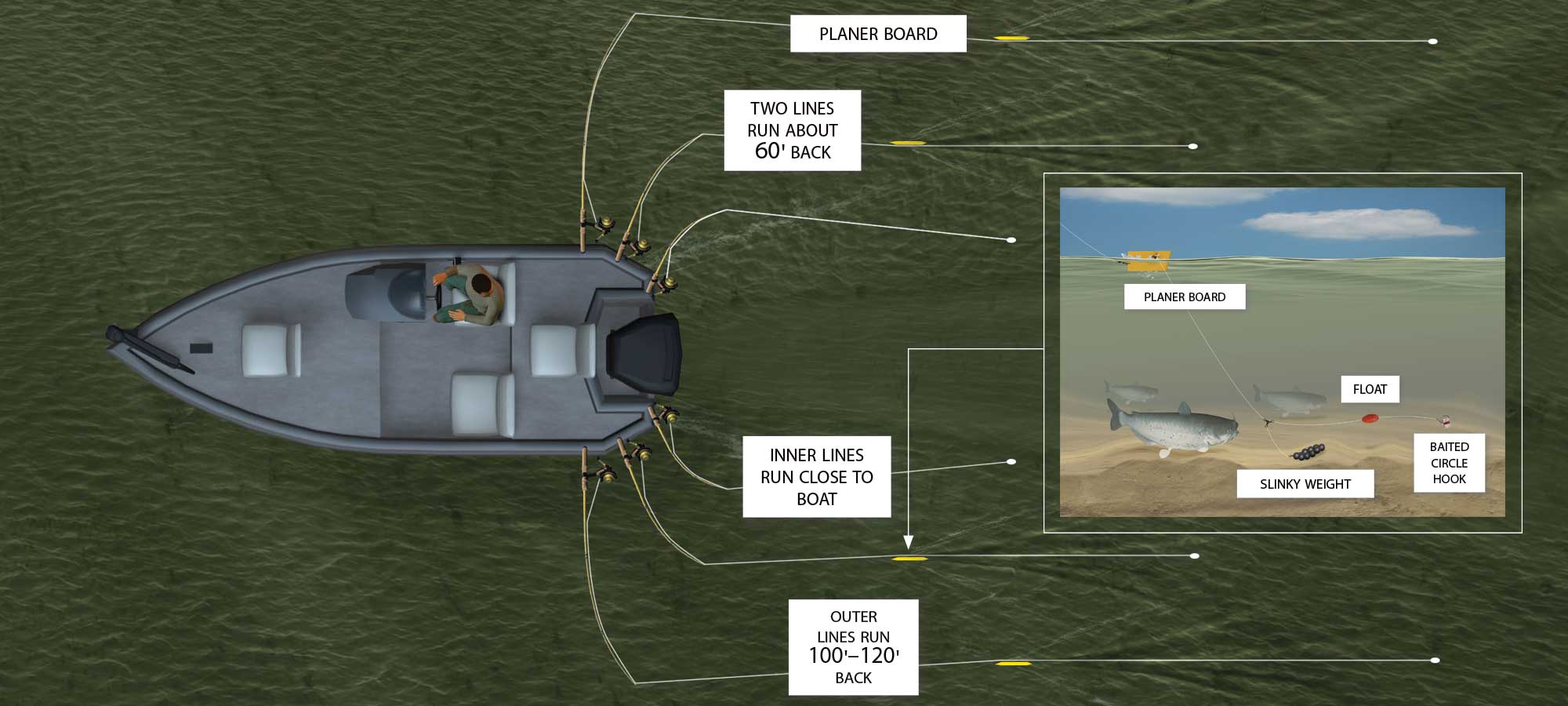
Spread Offense – The Other Bottom
If Zakk Royce is not locating fish on the bottom in the summer months, he will oftentimes look to the thermocline for schools of blue cats. “In the hotter water, big catfish will relate to the thermocline like it’s the bottom. In these instances, I set the depth of my bait under planer boards to be just above the thermocline. It can be lights-out, and almost nobody else targets these fish.” —J.B.
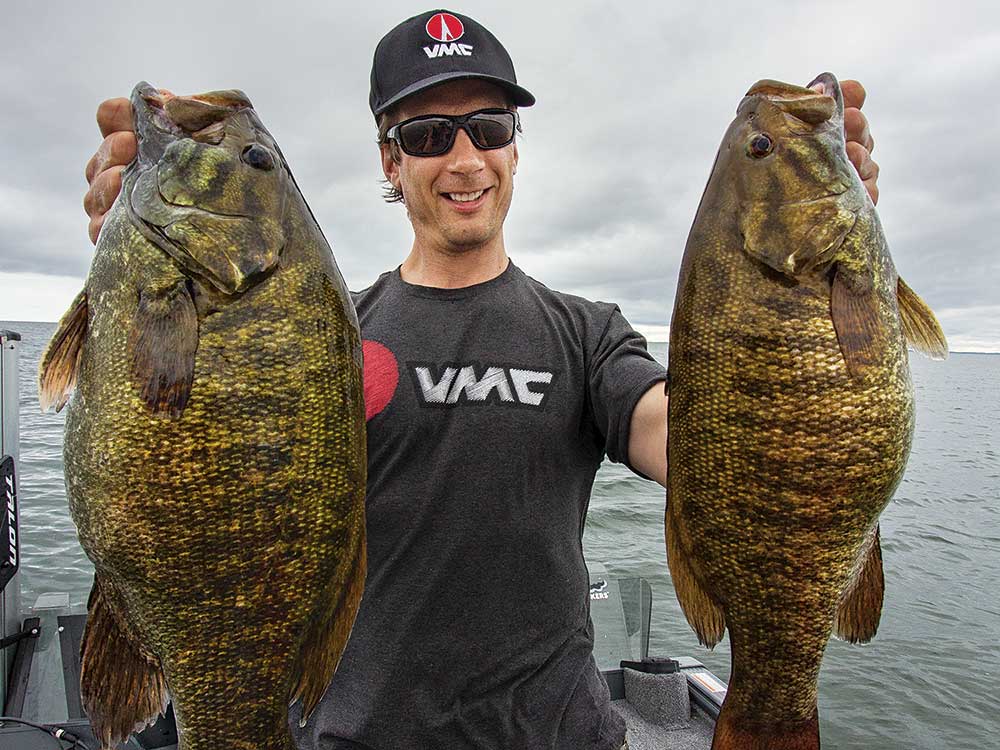
2. BASS
Fishing Fast With Slow Baits for Bass
Michigan native Randy Ramsey, 55, isn’t the type of angler who is afraid to try something new. Especially when that something new is really just something a bit different.
“A lot of guys fish tubes, but not many of them work them fast,” he says. “When the fish are on this, you can really catch them in a hurry.” Here’s how Ramsey does it.
He starts with the standard tube setup—spinning tackle, moderately light line, and a basic tube jig rigged on a ¼-ounce head. But that’s where the standard ends and the unusual begins.
Rather than dragging the bait methodically across the bottom with an occasional hop, Ramsey works the bait quickly using a steady pulling cadence.
“It’s almost like you’re working a jerkbait, but you’re doing it without moving the bait a long way,” he explains. “To do that, you need a long, limber rod. You pull the bait along and load up the rod, catching the bait up on the bottom or among sparse weeds. When the bait pops free, it’s not going very far, but it’s moving right along.”
The bite is most likely going to come after the bait hangs up on a piece of vegetation and then snaps free.
“You’ll be going along, loading the rod up on those sparse weeds, and then it’ll load up again—but when you go to pop it free, you realize there’s a fish on it.” Tubes work well, but Ramsey also likes to employ an Erie Darter, made by Indiana-based Poor Boys Baits.
“I’ll use the Darter a lot—it works really well during pre-spawn,” he says. “But you can catch them all year with this.”
Pro-Tip: The Hook Matters
According to Randy Ramsey, when you’re working tubes and darters quickly, hook choice is critical. “I prefer a light-wire hook for this because you aren’t setting the hook on the fish,” he says. “They’re going to hook themselves. The light wire makes that easier. And, of course, those hooks must be as sharp as you can get them.” —T.H.
3. MUSKELLUNGE
Sound Off on Muskies
Muskie anglers are a psychotic lot. A bass fisherman would be pissed if he saw a bass and didn’t catch it. But let a muskie guy get a glimpse of one of these toothy critters and you’ll see a celebration at the end of a biteless day. Native Minnesotan Jeff Andersen believes he has found a cure for the psychosis, and offers a concept that will turn exciting follows into an armload of hooked fish.
Andersen wears a lot of hats in the muskie world. He operates a six-boat guide service on Minnesota’s Leech Lake, runs a media services company for the fishing industry, and is the host for the Across the Ice Belt television show. So the 37-year-old Baxter, Minn., angler’s life revolves around chasing the ever-wary muskellunge.
“If a guy is serious about catching a lot of these fish, he not only needs to use a bait that gives him the best opportunity, he also needs to get his mind right,” Andersen explains. “For the bait, you can’t beat a bucktail.” But not just any bucktail will do. An interesting new line of lures from Big Tooth Tackle offers muskies something they’ve never heard before. There are three models in this Sound Science lineup, each with very different, and very specific, blade configurations—Rolling Thunder, Pulsator, and Sonic Boom.
“The idea is to create a bait with a unique vibration pattern, which sends specific frequencies through the water. While every muskie guy has bucktails in his tackle box, they are basically all the same, sending out similar vibration patterns. To give a fish something it hasn’t seen—or, more specifically, hasn’t heard—is the difference between a fish just following a lure or crushing it.”
The mental aspect of Andersen’s system may be a little tougher for the muskie loyalist to wrap his flannel-covered arms around.
“To catch a lot of fish, you have to perfect the game of efficiency. You need to cover as much water as possible so you can contact as many fish as possible. Typically, if an angler sees a fish, he will burn half a day trying to coax that specific fish into biting. That’s a mistake. Create a milk run and stick with it. And when using one of these new bucktails, you can cover water super fast. You can fish it shallow, deep, over grass, around rock. You don’t waste time changing baits. You keep a lure in the water all the time,” Andersen says. His best day fast-fishing a milk run yielded 13 muskies, with a 51-incher anchoring the day.
To cast this lure, he uses a 9-foot 1-inch to 9-foot 7-inch baitcasting rod. This allows for wider sweeps on figure 8s.
His reel of choice is a Revo Beast spooled with 80-pound Spiderwire, with a 150-pound fluoro leader.
“Muskie god Pete Maina came up with the idea of altering sound frequencies to inspire muskie strikes, and we worked together to perfect it.
“He was fishing behind two other anglers in the boat who were both throwing bucktails. Pete was throwing a prototype bucktail with reversed blades (which drastically altered the frequency of vibration) to test it against the other baits. He caught three fish behind those two guys—they never even got a follow,” Andersen says. “I’m telling you, the science of sound frequency is going to change muskie fishing.”
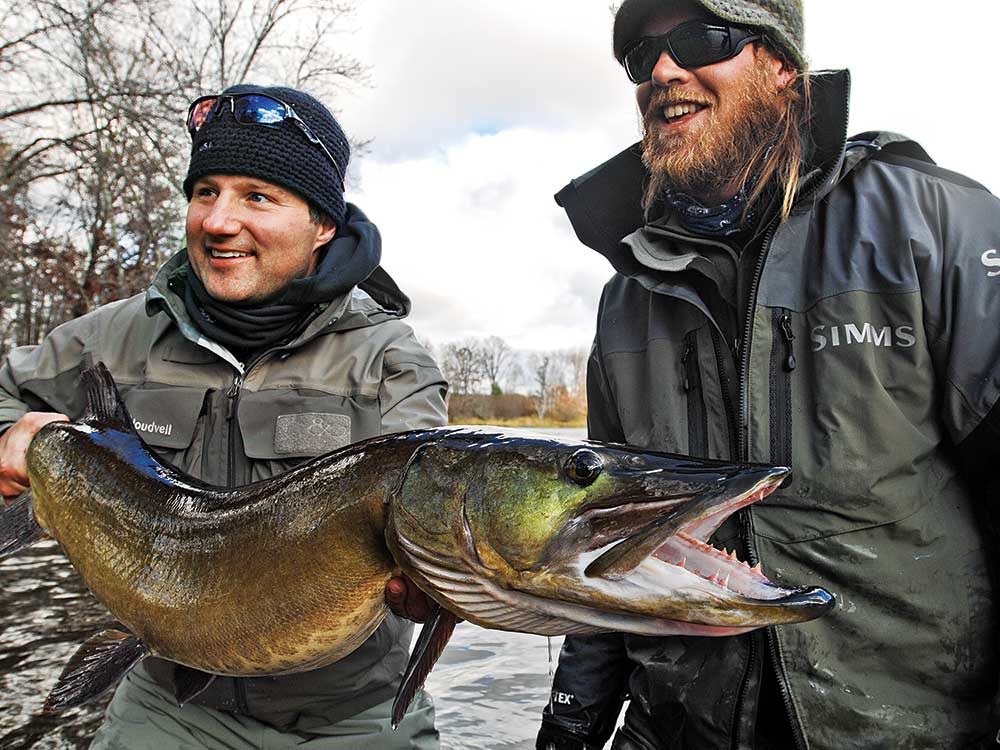
Pro-Tip: Quick Photo Op
Jeff Andersen understands why anglers soak in the moment when they land a fish. However, he says, do not savor the success for too long if you want to hook up again in a hurry. “The window for catching muskies can be super short. Take a photo and release that fish quickly, because your chances of hooking up again will never be higher than while you are celebrating the fish in the net.” —J.B.
4. STREAM TROUT
A Trout Threesome on the Short Line
It doesn’t matter which trout species you prefer to target, or even the type of fishery you prefer to wade. Longtime Colorado guide Anthony Bartkowski believes he has developed the ultimate rig to catch more fish than the Brad Pitt–wannabe just down the crick.
“Leave that River Runs Through It crap at the house. You don’t have to be able to double haul or have the accuracy to hit the head of a dime at 50 yards. All you need to be able to do is perform a simple 10-foot roll cast,” the 45-year-old says. “It’s all about the rig and how you present it. I’ve used this three-nymph system to catch rainbows, cutthroats, brookies, browns, and cutbows from little streams and big rivers.”
His rig starts with a 9-foot, 5-weight fly rod spooled with standard floating fly line. Next, he adds a 7 ½-foot 3X tapered leader, which is then tied to a 12-inch 3 X 6-pound-test tippet. He ties an attractor fly to the tippet— something bright and flashy to get the attention of the fish. Then he ties another 12-inch tippet to the bend of that fly and adds a nymph. He ties another 12-inch tippet to the bend of the nymph hook and terminates the rig with an emerger. With the three flies attached (check to ensure multiple flies are legal where you fish), each matching the hatch he is facing, Bartkowski adds a small split-shot weight above the knot between the leader and the tippet. And finally, he adds a strike indicator. He puts that at the same distance above the split shot as the split shot is above the last fly.
“Once your rig is ready, wade into the river or stream and identify 45-degree angles upstream and downstream. This is your drift. Make a 10-foot roll cast upstream and let the flies dead-drift to your mark downstream. Your arm should be like a protractor. You focus solely on this 20-foot section. Once you have carpeted this drift, move farther into the stream or farther up the run, and repeat.”
The beauty of this setup, according to Bartkowski, is that you’re covering three depth zones at once. The weight takes the attractor fly to the bottom, leaving the other two flies drifting above it. The systematic approach of this short-line system ensures the baits can be seen by every fish in the stream. With the simple cast, you seldom waste time untangling and retying.
“Every day is a good one with this rig,” Bartkowski promises. “But my best day ever using it resulted in more than 100 rainbows. I was fishing the North Fork of the South Platte River outside of Colorado Springs a few years back. It was early spring, and the trout were on a crazy-good egg take. It seemed like I caught a fish every cast for three hours. And on four casts, I landed a double.”
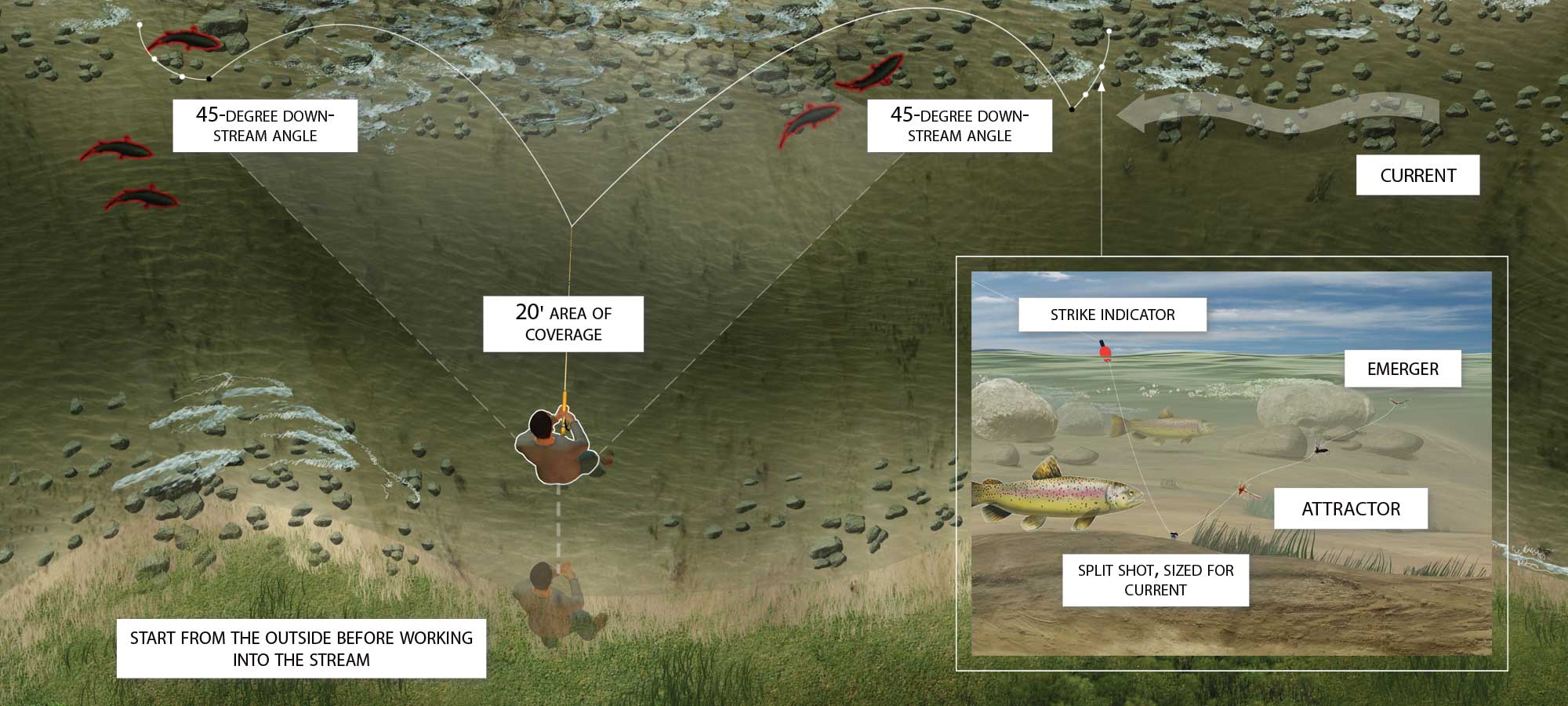
Pro Tip: Be a Proper Jerk
When you set the hook with the short-line, three-nymph rig, make sure you know which way to jerk, says Anthony Bartkowski. “Remember that your fly is drifting downstream, so the fish likely will eat it facing upstream. Always set the hook by lifting your rod downstream. Otherwise, you’ll pull the fly out of the fish’s mouth.” —J.B.
5. CRAPPIES
Roadrunning for Slabs
“I almost feel guilty,” says veteran crappie guide Jerry Thompson when he’s talking about catching pre-spawn crappies. “We catch so many, I start feeling a little bad for the fish. But I get over that quickly,” he says with a laugh. The 45-year-old Toledo Bend guide is talking about a very specific tactic that works from late February through mid-April.
“It’s the Roadrunner, man,” Thompson says. “This old-school bait has been forgotten by most crappie anglers these days. Guys now prefer little crankbaits and grubs. But the Roadrunner is the deal. It really shines in the pre-spawn, but it will catch fish all year long.”
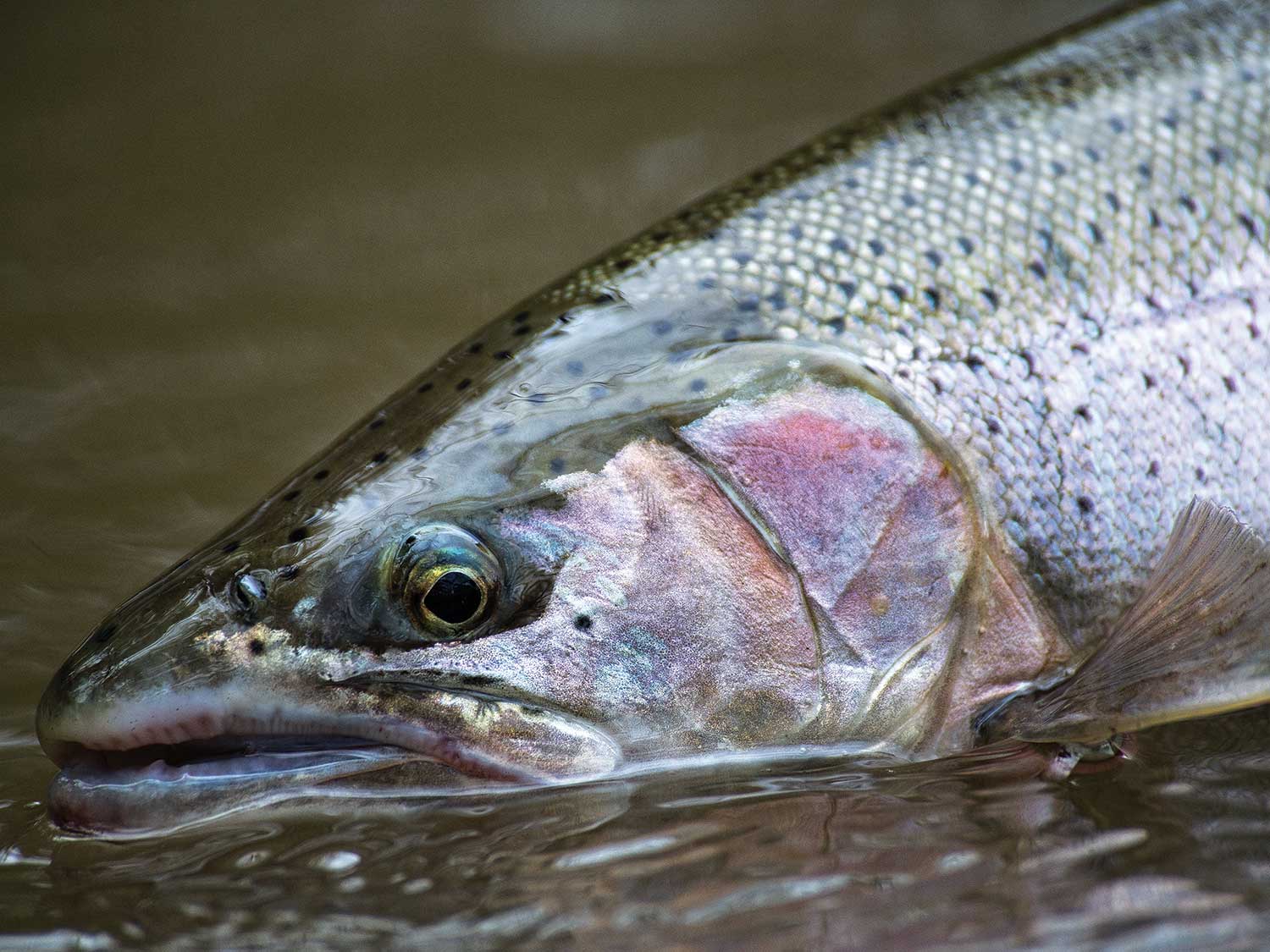
Pro-Tip: Know Your Eggs
Steelhead remain in the upper Niagara River most of the year because there’s always a species of fish laying eggs there from late September through June, according to Frank Campbell. “Salmon start spawning in late September. They’re followed by lake trout, then brown trout, then steelhead. The color of the eggs changes from one species to another, which dictates what color will be most effective. Know what is spawning when you get on the water, and pick your baits accordingly.” —J.B.
Thompson’s gear is pretty simple. He almost always uses the ¹/₈-ounce version of the underspin horsehead jig. To this jighead, he attaches a black-blue curly tail grub with a chartreuse tail. “You’ll catch fish on other colors. But I’m telling you, if they aren’t biting this color, they aren’t biting,” Thompson says. He casts it on an ultralight baitcasting outfit, which includes a medium-action crankbait rod and a low-profile baitcaster spooled with 8-pound fluorocarbon.
“The bait and setup are easy. The tough part can be finding the fish, unless you know what to look for. Focus on drains that terminate in a spawning flat. These will be 4- to 12-foot-deep ditches that creep up onto really shallow areas, where the crappies will spawn,” Thompson says. “I’m not talking about major creek channels. Look for the subtle little drains. When you find this structure, fan-cast the deep edges. Once you get bit, you’ve probably found a big school of fish.”
If there is grass in the area, Thompson will let his Roadrunner sink to the top of the grass and then slowly reel the bait so it moves just above the vegetation. The fish will be suspended in the grass. If there’s no grass, simply let the bait fall to the bottom and slow-roll it back to the boat.
“You want to reel it just fast enough to feel that little blade spin,” Thompson explains.
“I catch crappies every way imaginable. That’s my job. But this Roadrunner deal is my favorite.
“Before they changed the limit on Toledo Bend 15 years ago, a buddy and I found one of these little drains and caught 150 fish in a 100-yard stretch in an hour. They were all giants,” Thompson says. “And that’s not the best part. We did this for two solid weeks. But that’s still not the best part. We fish that same area today and catch fish. Fish will use the same pre-spawn staging area year after year, so once you locate it, you’re set,” Thompson says. “We’ve been beating up these fish for a decade and a half. See why I feel a little guilty?”
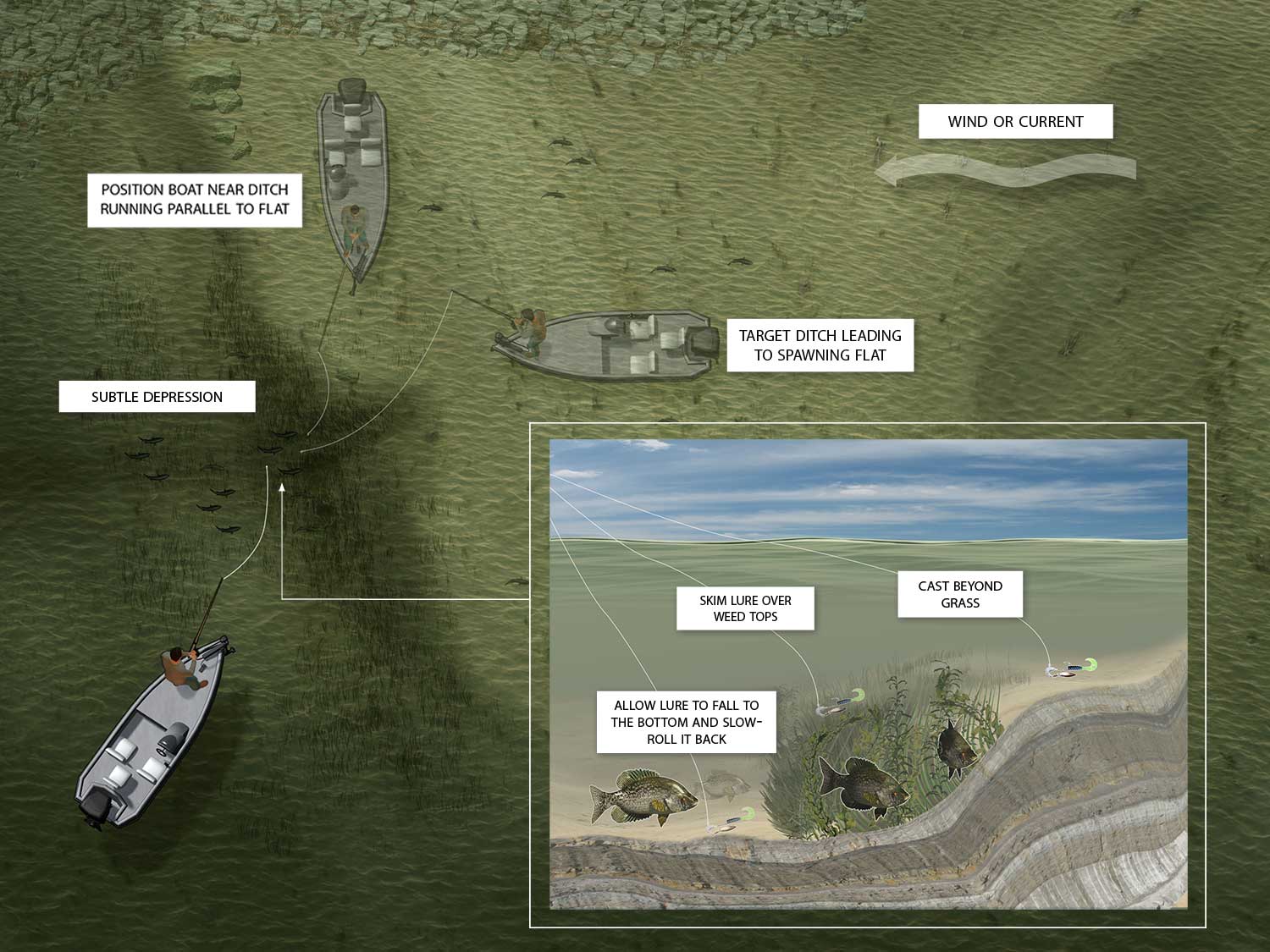
Pro Tip: Clearly Defined
Jerry Thompson rarely uses a grub that isn’t black/blue with a chartreuse tail. But he does change the color of his Roadrunner head based on water clarity. “In clear water, I go with white. In slightly stained water, I opt for orange. In really dirty water, chartreuse gets the nod,” he explains. “It’s amazing the difference this little color alteration can make.” —J.B.
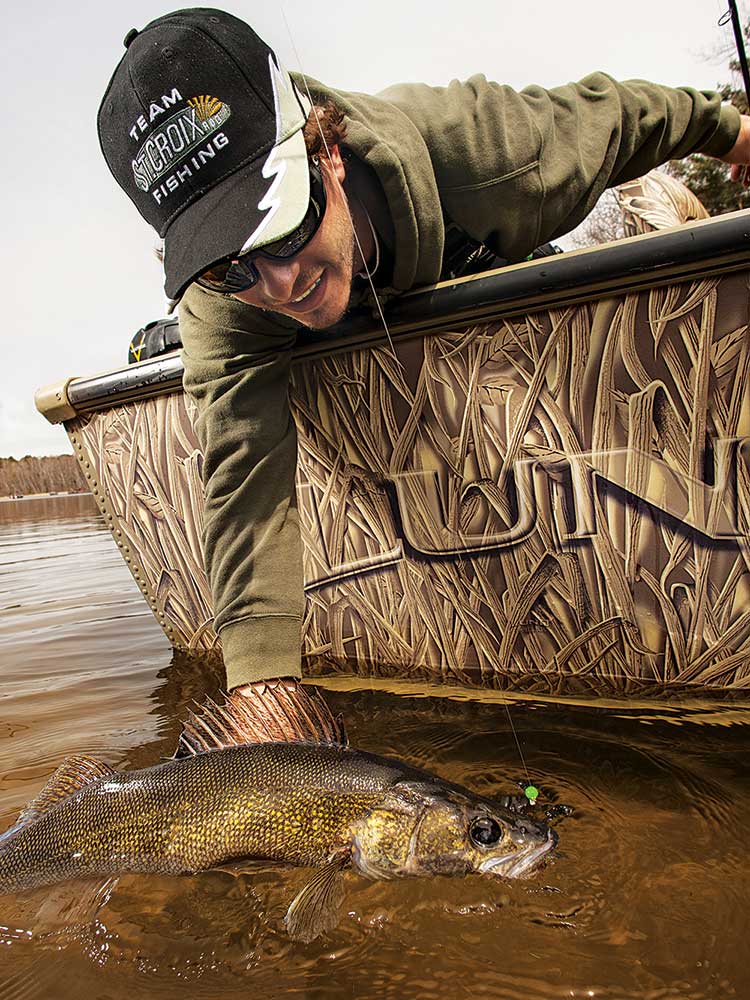
6. STEELHEAD
Double Down on Steelhead
After you’ve guided for steelhead for a few years, you learn a trick or two. After more than a quarter century on New York’s Upper Niagara River, Frank Campbell, 45, is a master magician. The number of fish he’s landed is in the thousands, and for this he credits an old, little-used tactic.
“My secret weapon is what I call the Double Hypotenuse Rig. It’s a clunky name, and not many people know how to spell it, but it makes sense, kinda,” Campbell says. A hypotenuse is the longest side of a right triangle, opposite the right angle. Campbell’s rig hinges on a perfectly vertical drop and the use of a three-way swivel, with the longest line holding his baits.
“My main line is connected to the swivel. My 12-inch dropper line is connected to a 1-ounce pencil weight. The third line is a 7-foot length of 6-pound fluoro. On this line, I attach a hook with a snelled knot and leave about 12 inches of tag end so I can attach a second hook. Most guys don’t attach this second hook, and that’s a huge mistake.”
Campbell uses a small No. 8 hook for the snell, and then an even smaller No. 10 for the second hook.
To the front hook, he usually attaches an egg sac, and he places a yarn ball on the second hook.
Pro-Tip: Double The Spin
If water clarity is poor, walleye pro Ross Grothe will spice up his Slow Death rig. “If I think the fish are having a hard time homing in on the crawler, I’ll add a spinner just above the hook. Now you have a worm rotating, as well as the vibration and flash of a spinner.” —J.B.
“When the rainbows, browns, and steelhead start dropping eggs, they do not shoot one out at a time. So this double-egg presentation is much more natural looking to fish. When they see several eggs drifting down the river at the same time, it’s much more convincing than using a single egg.”
Campbell says staying perfectly vertical with the main line is critical for presenting the baits as he drifts with the current. “It not only allows the baits to look more natural, but it also keeps you from getting snagged in the rocks. Just keep bouncing that pencil weight off the bottom to maintain contact and keep your lures in the strike zone.”
Although an average six-hour day using this technique will yield 10 to 15 fish, Campbell remembers an outing last fall where his Hypotenuse Rig accounted for a truly memorable flurry of fish.
“We had everything just right. The colors of the eggs and yarn balls must have been perfect. We landed more than 40 fish in six hours, with a 6-pound average. We had several doubles on one rod, but we had two 6-pounders on 6-pound-test that were fighting against each other. With the Niagara River current, that never ends well. The fight was fun while it lasted, though.”
7. WALLEYES
The Spinning Worm of Death
“Reinventing the wheel in walleye fishing is pretty tough,” says 48-year-old Ross Grothe, who has been a professional walleye angler half his life. “The most recent big deal to hit the sport really isn’t recent at all. It’s called the Slow Death approach to trolling, and there is no better way to catch a ton of walleyes anywhere in the country. That said, I don’t think many recreational anglers have any confidence in it.”
The setup should be familiar to even novice anglers.
“I use a 7-foot 6-inch medium-heavy St. Croix baitcasting rod with an Abu Garcia Silver Max reel—it has a flipping switch, which allows easy depth control without having to engage the spool. I use 10-pound-test Berkley Fireline and tie directly to a bottom-bouncing rig. I add a high-quality swivel to the snap on the bottom bouncer, and tie on a 3-foot, 8-pound-test fluoro leader. And to this I tie on the Mustad Slow Death hook. This is key. The hook has a crazy bend to it that makes it spin, even at very low speeds,” the Minnesota native explains.
The walleye pro will thread a nightcrawler on the hook, just past the knot, and then pinch off the worm 1 inch below the barb.
“All you do is drop the bait to the bottom and find the speed the fish want. I usually start at .7 mph and troll up to 1.2 mph, but never faster. And I always maintain bottom contact,” Grothe says. This is the slow part of the equation. Sometimes it will feel as if the boat isn’t moving. However, this allows anglers to very precisely drag this spinning worm through the narrowest of bite windows.
“The crazy thing is, the rig catches all sizes of fish and works in every type of fishery you can imagine. I’ve used it from 7 to 40 feet deep. I leaned heavily on this rig to win two tournaments last year en route to the Team of the Year title. We have caught 70 walleyes on this rig in less than six hours,” Grothe says. “It may not be flashy and it may not be cool, but bottom-bouncing a crawler on this hook will change your life—if a life can be changed by catching more fish.”
